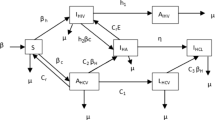Summary
Serial propagation of strains of all types of influenza viruses proved to be possible in a continuous cell line derived from a human bone carcinoma. This is the second continuous human cell line in which influenza viruses can be serially propagated. The concentration of influenza viruses in this cell line, G2, was essentially equivalent to the infectivity obtained in embryonated eggs. Clear-cut cytopathogenicity of the infected G2 cells did not occur. Viral antigenicity as determined by serum-virus hemagglutination-inhibition tests was not altered by the cell culture passage. Plaque assay of influenza viruses which had been serially propagated in G2 cell cultures was a simple procedure and the results were reproducible enough for practical application.
Similar content being viewed by others
References
Henle, G., A. Girardi, andW. Henle: A non-transmissible cytopathogenic effect of influenza viruses in tissue culture accompanied by formation of non-infectious hemagglutinins. J. exp. Med.101, 25–41 (1955).
Deinhardt, F., andG. Henle: Studies on the viral spectra of tissue culture lines of human cells. J. Immunol.79, 60–67 (1957).
Wong, S. C., andE. D. Kilbourne: Changing viral susceptibility of a human cell line. I. Production of infective virus in a variant of Chang conjunctival cell following infection with Swine or NWS influenza viruses. J. exp. Med.113, 95–111 (1961).
Green, I. J.: Serial propagation of influenza B (Lee) virus in a transmissible line of canine kidney cells. Science138, 42–43 (1962).
Kilbourne, E. D., A. Sugiura, andS. C. Wong: Serial multiplication of an influenza virus (NWS) in certain human diploid cell strains. Proc. Soe. exp. Biol. (N.Y.)116, 225–228 (1964).
Sugiura, A., andE. D. Kilbourne: Genetic studies of influenza viruses. II. Plaque formation by influenza viruses in a clone of a variant human heteroploid cell line. Virology26, 478–488 (1965).
Hatano, M.: Difference of interfering activity related to variants in influenza vims. Symp. Cell. Chem.15, 63–73 (1965).
Cooper, P. D.: The plaque assay of animal viruses. Advanc. Virus Res.8, 319–378 (1961).
Takemoto, K. K., andP. Fabisch: Influence of acid polysaccharides on plaque formation by A 2 and B viruses. Proc. Soc. exp. Biol. (N. Y.)114, 811–814 (1963).
Hoyle, L.: The growth cycle of influenza virus A. A study of the relation between virus, soluble antigen, and host cell in fertile egg inoculated with influenza virus. Brit. J. exp. Path.29, 390–399 (1948).
Henle, W., andG. Henle: Studies in host virus interactions in the chick embryo-influenza virus system. III. Development of infectivity, hemagglutinin and complement fixation activities during the first infectious cycle. J. exp. Med.90, 23–37 (1949).
Choppin, P. W.: Plaque formation by A2 virus in monkey kidney cells. Virology18, 332–333 (1962).
Simpson, R. W., andG. K. Hirst: Genetic recombination among influenza viruses. I. Cross reactivation of plaque forming capacity as a method for selecting recombinants from the progeny of crosses between influenza A strains. Virology15, 436–451 (1961).
Lehmann-Grube, F.: A sensitive plaque assay for influenza virus. Virology21, 520–522 (1963).
Green, I. J., M. Lieberman, andW. J. Mogabgab: The behavior of influenza viruses in various tissue culture systems. J. Immunol.78, 233–239 (1957).
Grossberg, S. E.: Cytocidal assay and propagation of influenza viruses in cultured primary hamster kidney cells. Proc. Soc. exp. Biol. (N. Y.)113, 546–553 (1963).
Author information
Authors and Affiliations
Rights and permissions
About this article
Cite this article
Hatano, M., Morita, O. Multiplication and plaque assay of influenza viruses in a continuous cell line (G2) of human origin. Archiv f Virusforschung 20, 305–313 (1967). https://doi.org/10.1007/BF01241950
Received:
Issue Date:
DOI: https://doi.org/10.1007/BF01241950




